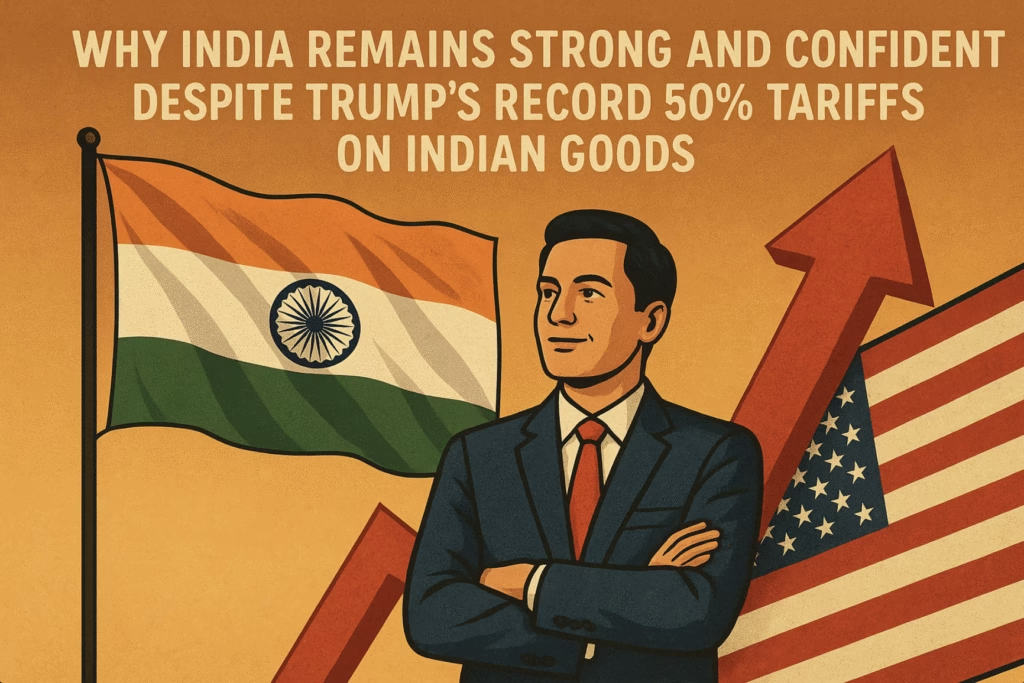Donald Trump administration announced 50% tariffs on Indian goods. The highest ever tariff imposed on any country. This comes after……

Donald Trump administration announced 50% tariffs on Indian goods. The highest ever tariff imposed on any country. This comes after US additionally imposed 25% tariff on India due to purchase of Russian oil, which has surprised many countries. China, Europe and US itself trade with Russia. In short run, this move has already started affecting India—the rupee has weakened, stock market has fallen, and exporters are in tense situation, they warning about big losses in sectors like textiles, gems, jewellery, and leather. Still India is showing strong confidence even Prime Minister Narendra Modi declined call from Donald Trump.
So why India is so confident despite heavy tariffs and diplomatic pressure.
The answer lies between strengths of Indian economy.
Strong foreign exchange reserve
India today has a strong foreign exchange reserve at all time high, India today is in much better situation than in the 1991 crisis. The country now has around $700 billion in foreign exchange reserves, this money acts like shield for RBI to strengthen rupee, control the fall of rupee and avoid panic situation where weak currency results high inflation and economic instability.
Improved economic reputation
India’s overall economic health is improved. Recently, Standard and Poor’s upgraded India’s credit rating to ‘BBB’- in 18 years this upgrade happened because of
- Robust economic growth: India’s real GDP growth averaged between FY2022 to FY2024 is 8.8% making it one of the fastest growing major economy.
- Fiscal discipline: the government is significantly reducing the fiscal deficit of the country (from 9.2% in 2020 to 4.4% to 2025), improving the quality of public spending, increasing spending in capex or in infrastructure and trying to lower debt GDP ratio in the coming years.
- Inflation management: India has managed its inflation in best way which fell to 2.82% in May 2025.
- Resilience: India is showing steady growth and resilience in tough condition like such as Trump tariffs.
Dependency on domestic demand
India is not net exporter country, India’s dependency is always on domestic demand means mostly driven by its people and 60% of GDP comes from the consumption and household spending. This means India doesn’t collapse when the exports come down it will still shine. It will affect but not much, at the same time government planning to reducing GST this Diwali, cutting red tape, and making it easier for investors to do business in India. This gives again boost in consumption in the country and indirectly in GDP.
Government and RBI taking actions.
Both the government and the RBI are actively supporting the economy to reduce impact of Trump tariffs. The RBI is ready to provide liquidity, use foreign reserve to support the rupee and adjust interest rate if it needed.
The Government is preparing export incentives, subsidies, and a ₹2,000–2,500 crore export promotion plan. Special help is also being arranged for MSMEs (small and medium businesses), which are likely to be most affected.
Finding new trade partners
India is reducing their dependency on only one country and finding new exporters to replace the US exports. It is working to expand trade with Latin America, the Middle East, Southeast Asia, and China. For example; with the 50% tariffs on textile in US this products goes to different countries. This means goods meant for US will go for different country.
Geopolitical and economic angle
Many see US action as actual attempt to separate Russia and India ties, push away Russia from India but that is not going to happening but this Trump tariff will impact on US and India relation damage for the long term.
In return India is strengthening their ties with other countries like
Ties with Russia, expanding trade with China and the deeper engagement with Middle East. Interestingly, the US has already shown signs of softening. The US Treasury Secretary has said the tariff issue is “temporary” and that both countries will “come together” later.
Conclusion
Despite 50% tariffs on India by Trump administration, India is confident enough to tackle this geopolitical tensions with strong economic fundamentals, resilient domestic demand, and proactive policy response. In essence, while the tariffs may cause short-term pain, India’s resilience, self-reliance, and strategic global positioning make it confident of weathering the storm — and even turning it into an opportunity to strengthen its role in the world economy.